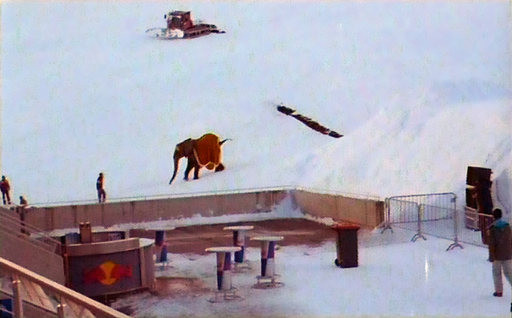ALPI BY ARMIN LINKE, RENATO RINALDI, PIERO ZANINI

Armin Linke, Alpi Film Project, film installation, film still, 2008, Courtesy the artist © Armin Linke
The shooting of 40 different locations in relation to the Alpine landscape creates a setting in which the research subject emerges: firstly, learning to understand how the visualization of the Alps has become part of our cinematic, cultural and industrial memory, secondly, learning to develop a language that we can use to unpack the contradictions of a complex image which is psychologically and politically determined by a western modernity and fragmented through globalization. Without an instance of judgment, Alpi suggests an index of images of the Alps that spans a tension between the image-representation of an Alpine landscape and, at the same time, the urgent question of how representation has become already an inhabitation of this image.
By the end of the 19th century, the Italian painter Giovanni Segantini mapped the social-human existence in Nature in the monumental Alpine Triptychon La vita, La Natura e La morte (The Life, The Nature and The death, 1896–99). The panoramic installation at the Segantini Museum in St. Moritz, in combination with Segantini’s proposal of a live-cinema-like presentation at the 1900 World Exhibition in Paris, delivers inspiring points of references for the spatial concept of Alpi.
Although the project applies a documentary film practice, it is not a documentary. Some sequences are filmed in a way that is reminiscent of a photographic landscape genre and others constitute a large group of tableaux vivants. They all share a situation of everyday life, though, highly diverse: from the Alpine farmer chained to tradition, to the Arab business man who looks out from a large window at a three-dimensional staging of an Alpine ski-landscape, that forms part of the architecture of a neighbouring shopping mall in Dubai. In contrast to a scientific experiment which might use images as evidence of a thesis, Alpi starts the other way around: 40 hours of film material complicate an image of the Alps as a screen for terms such as ‘the Heimat’ and ‘the exotic’.
Examples of this include the German 'Heimatfilm' of the early 20th Century that repetitively brand the individual as being overwhelmed by the wide verticality of a landscape, which would bear an uncanny desire of a territorial naturalness, whilst 80 years later, the Alps serve as a location for an Indian Bollywood-film partly because, for example, the massif of Kashmir has become a politically troubled region and is inaccessible, but also perhaps because the European landscape suggests similarity and associations with economic wealth. The excess of technical reproducibility of an image of the Alps may make us want to conceal an imaginary ‘imperative image’ that is imbedded into bio-politics and a global economic network. Alpi could be a case study to explore; that a surplus of images for comparison activates a withdrawal from a visual compulsion. This action might have the power to free the geo-politics of a region from its visual imprisonment. It might assist us to re-learn the ability to see.
The project-makers utilize the technique of montage to initiate silence between sounds and blindness between images. When the film is shown in the gallery context, exhibition architecture also instigates the possibility of montage with spatial means. It is easily possible to work with more than one screen creating an asynchronous mode of reception of the multiple exposures. Montage through spaces implies visitors through their bodily movement. The labour of looking is shared with the viewer who is not restricted only to the place of an audience. Alpi plays out that which had been claimed by the Dziga-Vertov-Group in the 1960’s: montage before, during and after shooting.
This democratization of the gaze aims not to teach the viewer from a position of knowing as Brecht might have proposed. The setting activates an emancipation of the viewer by putting him/her into the role of the maker who knows enough to not know the ultimate conclusion. A cinematic installation turns the space into the performance of an editing room, in which viewer and author enter an archaeological investigation to re-frame an image of the Alps: to ‘des-imagine’ an image. The Alps take place in the very moment of the experience of ‘desimaging’, which could help us to re-politicize both the image and our imagination with cinematic means.
Doreen Mende
